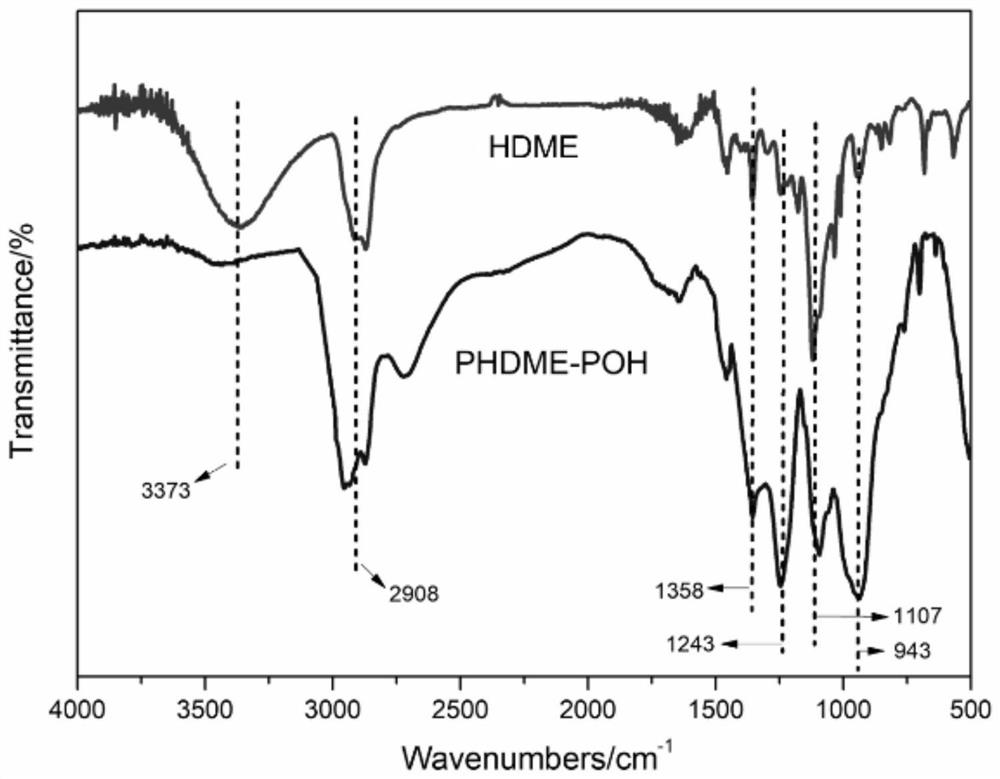A kind of anion exchange membrane loaded with cryptane unit and its preparation method
An ion-exchange membrane and cryptane technology, which is applied in the field of anion-exchange membranes containing cryptane structures and their preparation, can solve problems that do not involve the research of polyphosphazene anion-exchange membranes loaded with cryptethers, and achieve excellent alkali resistance, The effect of good stability
- Summary
- Abstract
- Description
- Claims
- Application Information
AI Technical Summary
Problems solved by technology
Method used
Image
Examples
Embodiment 1
[0034] Dissolve glycerol and triphenylchloromethane in 1,4-dioxane and stir for 3 days to obtain monohydroxyl-protected glycerol.
[0035] Dissolve monohydroxyl-protected glycerol in 1,4-dioxane, add NaH to it and stir for 1 h, then add ethyl bromoacetate, and stir overnight to obtain 3,6-dioxa-4-[( Triphenyl)methyl]-1,8-suberoyl chloride.
[0036] Dissolve bis-aza 18-crown-6 in acetonitrile, and add K 2 CO 3 and 3,6-dioxa-4-[(triphenyl)methyl]-1,8-suberoyl chloride, stirred overnight, with LiAlH 4 The product was reduced and deprotected with dilute hydrochloric acid to obtain hydroxymethyl-[2,2,2]-cryptate.
Embodiment 2
[0038] Take 3.06g of the hydroxycryptate structure represented by formula (3) or formula (4) and add 1.2eq of sodium metal into THF, heat to 50°C, and react for 24h. Then cooled to room temperature, and suction filtered to obtain a THF solution of cryptane sodium salt;
[0039] Add the above THF solution of cryptate sodium salt to the THF solution containing 8.3g of polydichlorophosphazene, and react at 50°C for 48h;
[0040] Add 14.95g of unsubstituted n-amyl alcohol and 1.2eq of metal sodium into THF, react at room temperature for 6h, and then filter with suction to obtain a THF solution of n-amyl alcohol sodium salt;
[0041] Add the obtained THF solution of n-amyl alcohol sodium salt into the above solution, continue to react for 24 hours, then cool to room temperature, remove the solvent, and wash the remaining viscous substance with a large amount of deionized water to obtain a light yellow elastomer;
[0042] Dissolve the resulting elastomer in 30mL THF, and dry it in ...
Embodiment 3
[0045] Take 9.18g of the hydroxycryptate structure shown in formula (3) or formula (4) and add 1.2eq of sodium metal into THF, heat to 50°C, and react for 24h. Then cooled to room temperature, and suction filtered to obtain a THF solution of cryptane sodium salt;
[0046] Add the above THF solution of cryptate sodium salt to the THF solution containing 8.3g of polydichlorophosphazene, and react at 50°C for 48h;
[0047] Add 13.38g of unsubstituted n-amyl alcohol and 1.2eq of metal sodium into THF, react at room temperature for 6h, and then filter with suction to obtain a THF solution of n-amyl alcohol sodium salt;
[0048]Add the obtained THF solution of n-amyl alcohol sodium salt into the above solution, continue to react for 24 hours, then cool to room temperature, remove the solvent, and wash the remaining viscous substance with a large amount of deionized water to obtain a light yellow elastomer;
[0049] Dissolve the resulting elastomer in 30mL THF, and dry it in a petri...
PUM
| Property | Measurement | Unit |
|---|---|---|
| separation | aaaaa | aaaaa |
Abstract
Description
Claims
Application Information
 Login to View More
Login to View More - R&D Engineer
- R&D Manager
- IP Professional
- Industry Leading Data Capabilities
- Powerful AI technology
- Patent DNA Extraction
Browse by: Latest US Patents, China's latest patents, Technical Efficacy Thesaurus, Application Domain, Technology Topic, Popular Technical Reports.
© 2024 PatSnap. All rights reserved.Legal|Privacy policy|Modern Slavery Act Transparency Statement|Sitemap|About US| Contact US: help@patsnap.com










